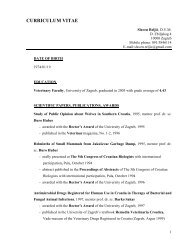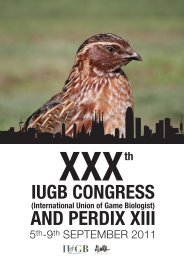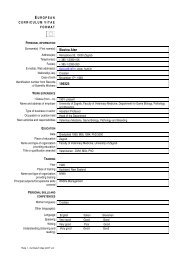Interplay between institutions and institutional change at the local level
Interplay between institutions and institutional change at the local level
Interplay between institutions and institutional change at the local level
Create successful ePaper yourself
Turn your PDF publications into a flip-book with our unique Google optimized e-Paper software.
http://fp7hunt.net<br />
WP2 Institutional aspects of hunting in Europe<br />
& eastern Africa Camilla S<strong>and</strong>ström<br />
Work package overview<br />
Environmental governance, including <strong>the</strong> governance of hunting <strong>and</strong> biodiversity management, is growing increasingly<br />
complex, involving multiple actors with multiple interests <strong>at</strong> multiple <strong>level</strong>s from intern<strong>at</strong>ional to <strong>local</strong>. We thus set out<br />
to investig<strong>at</strong>e <strong>the</strong> governance of hunting: How effective are modern governance arrangements in managing multiple<br />
interests in hunting <strong>and</strong> wildlife management? Wh<strong>at</strong> are <strong>the</strong> implic<strong>at</strong>ions <strong>and</strong> consequences of <strong>the</strong>se arrangements<br />
<strong>the</strong>mselves? How can <strong>the</strong>ir (potential) shortcomings <strong>and</strong> emerging problems be addressed? The objective of this work package<br />
was thus to analyse how <strong>institutional</strong> arrangements <strong>and</strong> <strong>institutional</strong> <strong>change</strong> influence hunting. Institutions are here understood<br />
as <strong>the</strong> ‘rules of <strong>the</strong> game’.<br />
2.3 The horizontal dimension: <strong>Interplay</strong> <strong>between</strong> <strong>institutions</strong><br />
<strong>and</strong> <strong>institutional</strong> <strong>change</strong> <strong>at</strong> <strong>the</strong> <strong>local</strong> <strong>level</strong><br />
2.3.1 Revenue sharing from wildlife tourism<br />
<strong>and</strong> hunting in Ethiopia<br />
Yitbarek Tibebe Weldesemaet & Anke Fischer<br />
Background<br />
Local people often bear <strong>the</strong> cost of protected area design<strong>at</strong>ions,<br />
including controlled hunting areas, as <strong>the</strong>y forego income from<br />
altern<strong>at</strong>ive l<strong>and</strong> uses. In many places across <strong>the</strong> world, revenue<br />
sharing schemes have thus been developed, based on <strong>the</strong><br />
assumption th<strong>at</strong> people will support wildlife conserv<strong>at</strong>ion if<br />
<strong>the</strong>y receive tangible benefits from it. We analyse here <strong>the</strong><br />
governance processes of a scheme th<strong>at</strong> aims to share revenues<br />
from trophy hunting <strong>and</strong> wildlife tourism in <strong>the</strong> Sou<strong>the</strong>rn<br />
N<strong>at</strong>ions, N<strong>at</strong>ionalities <strong>and</strong> Peoples Regional St<strong>at</strong>e, Ethiopia.<br />
In particular, we examine this scheme against <strong>the</strong> backdrop<br />
of <strong>the</strong> liter<strong>at</strong>ure on <strong>the</strong> governance of co-management, to<br />
explore if <strong>the</strong> criteria found as important for <strong>the</strong> success of<br />
co-management arrangements can help us to improve <strong>the</strong><br />
governance of revenue sharing.<br />
Qualit<strong>at</strong>ive d<strong>at</strong>a were collected through a combin<strong>at</strong>ion of<br />
document analysis, semi-structured interviews, focus group<br />
discussions <strong>and</strong> stakeholder workshops th<strong>at</strong> included<br />
governmental authorities as well as community members.<br />
Activities Region Zone District Community PA<br />
Design<br />
of legisl<strong>at</strong>ion<br />
PA management<br />
planning<br />
Revenue<br />
collection<br />
Revenue<br />
alloc<strong>at</strong>ion<br />
High Low Zero Zero Low<br />
High Low Med Low High<br />
High Zero Zero Zero High<br />
High Low High Zero Low<br />
Monitoring High Low Zero Zero Zero<br />
Figure 2: Weight of <strong>the</strong> de facto role of actors in different components<br />
of <strong>the</strong> revenue sharing scheme, as identified through semi-structured<br />
interviews <strong>and</strong> a workshop with participants from all <strong>level</strong>s.<br />
PA=Protected Area.<br />
HUNT is an interdisciplinary intern<strong>at</strong>ional research project, financed by <strong>the</strong> EU’s 7th Framework program,<br />
looking into <strong>the</strong> wider meaning of hunting in <strong>the</strong> 21st century
http://fp7hunt.net<br />
Key findings<br />
All study participants welcomed <strong>the</strong> scheme <strong>and</strong> saw it as<br />
work in progress. Four areas of <strong>the</strong> current legisl<strong>at</strong>ion <strong>and</strong><br />
implement<strong>at</strong>ion practice were seen to require improvement:<br />
● Inform<strong>at</strong>ion on <strong>the</strong> detail of <strong>the</strong> scheme was lacking among<br />
many actors<br />
● Roles <strong>and</strong> responsibilities of <strong>the</strong> actors were imbalanced –<br />
district governments were very influential whereas <strong>local</strong><br />
communities tended to be passive (see Fig. 2)<br />
● Accountability was compromised, as limited provisions<br />
had been made for monitoring <strong>and</strong> evalu<strong>at</strong>ion<br />
● Disbursement of <strong>the</strong> shares was usually not associ<strong>at</strong>ed<br />
to hunting or tourism, <strong>and</strong> overall revenue was too limited<br />
to have an impact.<br />
The areas identified reflected <strong>the</strong> evalu<strong>at</strong>ion criteria for<br />
co-management, as presented in <strong>the</strong> liter<strong>at</strong>ure. However,<br />
one fundamental difference lay in <strong>the</strong> connection <strong>between</strong><br />
resource <strong>and</strong> revenue: While in co-management arrangements,<br />
this connection is usually <strong>at</strong> <strong>the</strong> centre of community <strong>and</strong><br />
government activities, a revenue sharing scheme such as <strong>the</strong><br />
one examined here does not establish a close link <strong>between</strong><br />
resource use <strong>and</strong> <strong>the</strong> amount of revenue disbursed to <strong>the</strong><br />
different actors. This disconnect constrains <strong>the</strong> potential<br />
positive effect of revenue sharing on resource users’ behaviour.<br />
Conclusions<br />
The revenue sharing scheme was established in 2007, <strong>and</strong> it<br />
was thus too early to assess its impacts on conserv<strong>at</strong>ion-rel<strong>at</strong>ed<br />
<strong>at</strong>titudes <strong>and</strong> behaviour. Our analysis of governance processes<br />
now informs <strong>the</strong> government’s current revision of legisl<strong>at</strong>ion<br />
<strong>and</strong> implement<strong>at</strong>ion practice. It seems unlikely th<strong>at</strong> <strong>the</strong> scheme<br />
will lead to <strong>at</strong>titude <strong>and</strong> behaviour <strong>change</strong> among <strong>the</strong> <strong>local</strong><br />
popul<strong>at</strong>ion in <strong>the</strong> future, given <strong>the</strong> missing connection <strong>between</strong><br />
conserv<strong>at</strong>ion-relevant behaviours <strong>and</strong> <strong>the</strong> amount of revenue<br />
distributed. This might be addressed by a turn towards comanagement<br />
of <strong>the</strong> protected areas, where responsibility for<br />
wildlife is shared <strong>between</strong> government <strong>and</strong> <strong>local</strong> communities.<br />
However, <strong>at</strong> a political <strong>level</strong>, formalised revenue sharing as in<br />
this scheme might help to make <strong>the</strong> monetary value of wildlife<br />
conserv<strong>at</strong>ion visible, thus providing arguments against l<strong>and</strong><br />
conversion.<br />
Read more in our research briefings from Ethiopia:<br />
http://fp7hunt.net/Portals/HUNT/Publikasjoner/<br />
factsheets/HUSA%20research%20briefings%20<br />
Ethiopia%20June%202012.pdf<br />
2.3.2 The influence of informal <strong>institutions</strong><br />
<strong>and</strong> social <strong>change</strong> on bushme<strong>at</strong> hunting<br />
in western Serengeti, Tanzania<br />
Asanterabi Lowassa & Anke Fischer<br />
Background<br />
Illegal hunting is often addressed by increased law enforcement<br />
<strong>and</strong> <strong>the</strong> cre<strong>at</strong>ion of monetary or m<strong>at</strong>erial incentives. However,<br />
not only formal rules such as laws, but also informal rules could<br />
help to reduce illegal hunting. We focus here on such informal<br />
<strong>institutions</strong>, th<strong>at</strong> is, established (but unwritten) norms <strong>and</strong> rules<br />
th<strong>at</strong> guide <strong>and</strong> constrain human behaviour in <strong>the</strong> society,<br />
such as <strong>local</strong> customs or taboos: Wh<strong>at</strong> is <strong>the</strong> role of informal<br />
<strong>institutions</strong> in shaping bushme<strong>at</strong> hunting in western Serengeti?<br />
We conducted focus group discussions with 76 participants<br />
from 8 villages in Me<strong>at</strong>u, Bunda <strong>and</strong> Serengeti districts,<br />
complemented by two consecutive workshops with a range<br />
of <strong>local</strong> stakeholders (n=15): elders, community members,<br />
<strong>the</strong> district game officer, represent<strong>at</strong>ives of conserv<strong>at</strong>ion NGOs,<br />
<strong>the</strong> Wildlife Management Area <strong>and</strong> TANAPA.<br />
Key findings<br />
● In <strong>the</strong> recent past, clan-specific social norms worked<br />
as taboos <strong>and</strong> prohibited <strong>the</strong> hunting of certain species<br />
(e.g., elephant, zebra)<br />
● Like <strong>the</strong> killing of <strong>the</strong>se taboo animals, also <strong>the</strong> use of certain<br />
techniques (e.g., pitfall traps) was seen to inflict misfortune on<br />
<strong>the</strong> hunter<br />
● However, <strong>the</strong>se rules have been eroding for a number of<br />
reasons:<br />
■ People need more cash as <strong>the</strong>y move from subsistence<br />
to a market economy<br />
■ Cultural <strong>and</strong> ethnic groups are mixing due to <strong>local</strong><br />
migr<strong>at</strong>ion, educ<strong>at</strong>ion, increased intermarriage<br />
■ Replacement of traditional religious beliefs with modern<br />
religion, e.g., Christianity<br />
■ Traditional authorities, such as elders, are not respected<br />
anymore.<br />
HUNT is an interdisciplinary intern<strong>at</strong>ional research project, financed by <strong>the</strong> EU’s 7th Framework program,<br />
looking into <strong>the</strong> wider meaning of hunting in <strong>the</strong> 21st century
http://fp7hunt.net<br />
Conclusions<br />
Informal <strong>institutions</strong> can be powerful tools to constrain<br />
bushme<strong>at</strong> hunting, but are very vulnerable to social <strong>change</strong>.<br />
As previously active norms might be impossible (or not<br />
desirable) to restore, altern<strong>at</strong>ive social norms th<strong>at</strong> fit with<br />
a modern society should be considered. Conserv<strong>at</strong>ion<br />
interventions should pay <strong>at</strong>tention to those areas where<br />
hunting is currently limited due to social norms th<strong>at</strong> are<br />
still in place – <strong>the</strong>se will likely <strong>change</strong> in <strong>the</strong> near future.<br />
Read more in our research briefings from Tanzania:<br />
http://fp7hunt.net/Portals/HUNT/Publikasjoner/factsheets/<br />
HUSA%20research%20briefings%20Tanzania%20April%<br />
202012.pdf<br />
2.3.3 Challenges associ<strong>at</strong>ed with introduction<br />
of an ecosystem-based management system:<br />
A diagnostic analysis of moose management<br />
in Sweden<br />
Camilla S<strong>and</strong>ström, Sofia Wennberg DiGasper &<br />
Karin Öhmanr<br />
Background<br />
Swedish moose (Alces alces) management has over<br />
<strong>the</strong> years gone from a situ<strong>at</strong>ion where open access <strong>and</strong><br />
unrestricted dem<strong>and</strong>s lead to over-exploit<strong>at</strong>ion, into a situ<strong>at</strong>ion<br />
characterized by abundance of moose. Whilst high numbers<br />
of moose are preferred by hunters, <strong>the</strong>y damage forests<br />
through browsing, causing conflicts <strong>between</strong> <strong>the</strong> hunters <strong>and</strong><br />
forest owners. In <strong>at</strong>tempts to resolve <strong>the</strong> disputes, <strong>the</strong> Swedish<br />
government is introducing a new <strong>local</strong> ecosystem-based<br />
management system. In this study we focus on how this shift<br />
from managing a single resource to <strong>the</strong> broader perspective<br />
of ecosystem management <strong>and</strong> discusses to wh<strong>at</strong> extent it will<br />
contribute to conflict resolution. We used a diagnostic approach<br />
based on a <strong>the</strong>oretical framework developed by Elinor Ostrom<br />
to analyse a specific critical case of moose management. Both<br />
desktop studies <strong>and</strong> interviews with relevant actors were<br />
conducted.<br />
Key findings<br />
● The diagnostic approach has helped us to underst<strong>and</strong><br />
<strong>the</strong> complex interrel<strong>at</strong>ionships <strong>between</strong> social <strong>and</strong><br />
biophysical factors <strong>at</strong> different <strong>level</strong>s of analysis.<br />
This has provided insights into <strong>the</strong> strengths<br />
<strong>and</strong> weaknesses of <strong>the</strong> current <strong>and</strong> new moose<br />
management systems in Sweden.<br />
● The new management system, introducing a new<br />
management <strong>level</strong> covering <strong>the</strong> ecosystem of a moose<br />
popul<strong>at</strong>ion, clearly has <strong>the</strong> potential to solve problems<br />
rel<strong>at</strong>ed to <strong>the</strong> current mism<strong>at</strong>ch of ecological <strong>and</strong> social<br />
scales arising from <strong>the</strong> moose being a migr<strong>at</strong>ory species <strong>and</strong><br />
<strong>the</strong> <strong>institutional</strong> <strong>and</strong> organis<strong>at</strong>ional p<strong>at</strong>chwork of property units.<br />
● However, some problems th<strong>at</strong> are not dealt with<br />
appropri<strong>at</strong>ely will probably be transferred from <strong>the</strong> current<br />
system to <strong>the</strong> future one. These problems rel<strong>at</strong>e to complex<br />
property rights system, represent<strong>at</strong>ion of hunters <strong>and</strong> l<strong>and</strong><br />
owners across <strong>the</strong> whole management system, <strong>and</strong> <strong>the</strong> fact<br />
th<strong>at</strong> <strong>the</strong> new management system is a mix <strong>between</strong> formally<br />
regul<strong>at</strong>ed management <strong>level</strong>s (n<strong>at</strong>ional, regional <strong>and</strong><br />
ecosystem-based) <strong>and</strong> voluntary based management (<strong>local</strong>).<br />
● Without <strong>the</strong> establishment of cross-scale linkages based<br />
on trust <strong>and</strong> reciprocity, <strong>the</strong> new management system will<br />
experience <strong>the</strong> same difficulties as <strong>the</strong> current system, <strong>and</strong><br />
will not contribute to resolving conflicts.<br />
Conclusions<br />
The introduction of ecosystem management will possibly<br />
remedy some of <strong>the</strong> problems rel<strong>at</strong>ed to <strong>the</strong> current<br />
management of moose in Sweden. However, <strong>the</strong> fragmented<br />
management structure where diverse owners (priv<strong>at</strong>e <strong>and</strong><br />
public, large- <strong>and</strong> small-scale) have different <strong>and</strong> potentially<br />
conflicting objectives is a challenge to <strong>the</strong> introduction of more<br />
holistic <strong>and</strong> overarching management principles such as <strong>the</strong><br />
ecosystem approach.<br />
Read more in our research briefing from Sweden:<br />
http://fp7hunt.net/Portals/HUNT/Reports/HUNT%20<br />
Swedish%20research%20findings.pdf<br />
For more inform<strong>at</strong>ion contact:<br />
Justin Irvine (Justin.Irvine@hutton.ac.uk)<br />
HUNT is an interdisciplinary intern<strong>at</strong>ional research project, financed by <strong>the</strong> EU’s 7th Framework program,<br />
looking into <strong>the</strong> wider meaning of hunting in <strong>the</strong> 21st century







